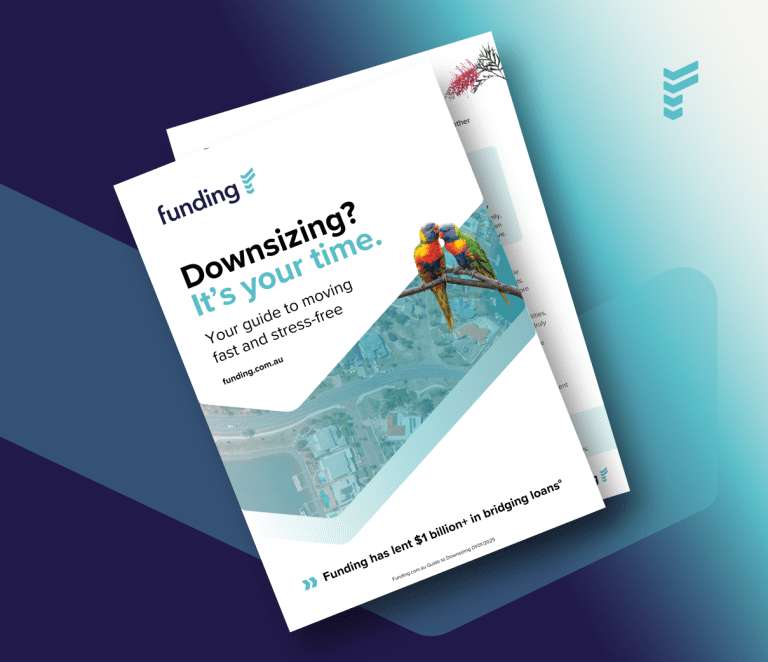What is a bridging loan?
A bridging loan is a short term loan designed to provide property owners with immediate access to funds when buying a new property before selling their current one. Bridging loans are commonly used in scenarios such as upgrading to a larger home, downsizing, or purchasing an investment property.
Key features of bridging loans:
- Short-term solution: Typically lasting between 1 and 24 months, providing flexibility during property transitions
- Interest-only payments: Borrowers usually make interest-only payments during the loan term, repaying the principal once their current property is sold
- Fast access to funds: Bridging loans provide quick access to capital, helping buyers secure new properties in a competitive market.
Banks vs private lenders: What’s the difference?
Property owners may choose between traditional banks and non-bank lenders, like Funding, when applying for a bridging loan. While both options provide bridging finance, there are notable differences in their lending processes, flexibility, and assessment of borrowers.
Speed of approval and flexibility
Banks:
- Slower approval process: Traditional banks tend to have more stringent lending criteria, which can result in longer approval times. Borrowers may have to provide extensive documentation, and the loan application process can be time-consuming.
- Less flexible terms: Banks often adhere to rigid loan terms and conditions, making it difficult for property owners to negotiate customised repayment schedules or adjust their loan structure if circumstances change.
Non-bank lenders:
- Fast approvals: One of the most significant advantages of non-bank lenders is their ability to approve loans quickly. Non-bank lenders often use streamlined application processes, allowing borrowers to access funds faster than they would through a traditional bank.
- More flexible terms: Non-bank lenders offer more flexible loan structures, allowing borrowers to customise repayment options, loan terms, and interest rates to suit their needs, which may be especially beneficial for property owners with unique financial situations or those needing short-lived financing.
Lending criteria and borrower assessment
Banks:
- Strict lending criteria: Banks typically have more stringent lending criteria, making it more difficult for borrowers with less-than-perfect credit or irregular income to qualify for a bridging loan. Banks often focus heavily on the borrower’s credit score, income stability, and loan-to-value ratio (LVR).
- Conservative risk approach: Traditional banks are often more risk-averse, which means they may be less willing to lend to borrowers with complex financial situations or properties in less conventional markets.
Non-bank lenders:
- Flexible lending criteria: Non-bank lenders tend to be more accommodating when assessing a borrower’s financial situation. They may approve loans for borrowers with non-traditional income sources (such as self-employed individuals) or those with a lower credit score.
- Willingness to take on higher risk: Non-bank lenders are often more open to taking on loans that banks might consider risky, such as providing loans for properties in rural areas, borrowers with irregular income streams, or those looking for a more personalised financing solution.
Interest rates and fees
Banks:
- Lower interest rates (sometimes): Banks often offer lower interest rates than non-bank lenders because they can access lower-cost capital and operate under strict regulatory guidelines. However, these lower rates may have less flexibility and longer approval times.
- Higher fees: Banks may charge higher fees for their loan products, including application fees, valuation fees, and legal fees, which can add to the overall cost of borrowing.
Non-bank lenders:
- Competitive but varied interest rates: Non-bank lenders typically offer competitive interest rates, but these rates may be slightly higher than those traditional banks provide due to the increased risk they take. However, many borrowers find that non-bank lenders’ speed, flexibility, and personalised service outweigh the slightly higher interest rates.
- Lower upfront fees: Non-bank lenders often have lower upfront fees, making the overall cost of borrowing more transparent and predictable for property owners.
Loan structure and repayment flexibility
Banks:
- Rigid loan structures: Banks typically offer standardised loan products with fixed repayment schedules and limited flexibility in adjusting the loan terms, which may make it difficult for borrowers who need more personalised solutions.
- Limited repayment options: While some banks offer interest-only repayments, they may have strict terms on how and when borrowers can repay the loan, often leaving little room for customisation.
Non-bank lenders:
- Customisable loan structures: Non-bank lenders excel in offering customisable loan products tailored to meet the borrower’s specific needs. These include flexible loan terms, interest-only repayments, and the ability to negotiate specific repayment schedules based on the borrower’s cash flow and financial situation.
- Early repayment options: Non-bank lenders are often more accommodating regarding early repayment. This flexibility allows property owners to repay the loan when their property sells—without incurring heavy penalties.
Customer service and personalisation
Banks:
- Standardised service: Banks often provide a more standardised service experience, where borrowers are treated more as numbers in an extensive system. Personalisation is limited, and the loan process can feel less tailored to individual needs.
- Less personal interaction: Bank borrowers may have less direct access to decision-makers and often need to go through multiple layers of customer service before getting answers or support.
Non-bank lenders:
- Personalised service: Non-bank lenders often offer more personalised and attentive customer service. Borrowers typically deal with smaller teams who are more responsive and can tailor solutions to meet the borrower’s needs.
- Direct communication: Non-bank lenders often allow borrowers to communicate directly with decision-makers, providing faster responses and a more hands-on approach to loan structuring and servicing.
Get started
At Funding, we specialise in providing bridging loans that are fast, flexible, and designed to meet the unique needs of property owners. As a non-bank lender, we offer many advantages over traditional banks, ensuring you receive the personalised support you need to make your property transactions smooth and efficient.
Learn more
For additional resources and information on short-term property loans and financing options, explore these helpful links:


